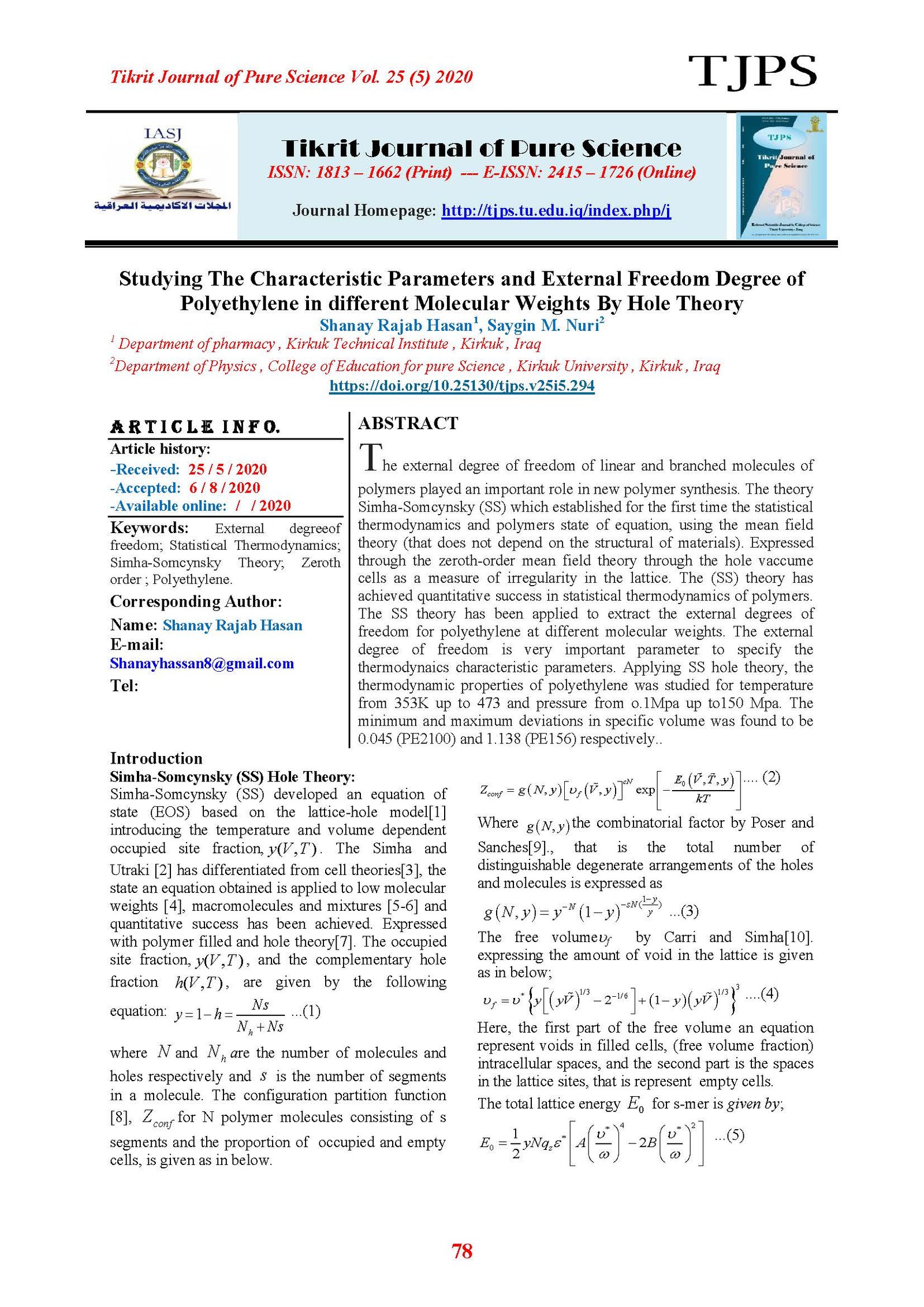Studying The Characteristic Parameters and External Freedom Degree of Polyethylene in different Molecular Weights By Hole Theory
Main Article Content
Abstract
The external degree of freedom of linear and branched molecules of polymers played an important role in new polymer synthesis. The theory Simha-Somcynsky (SS) which established for the first time the statistical thermodynamics and polymers state of equation, using the mean field theory )that does not depend on the structural of materials). Expressed through the zeroth-order mean field theory through the hole vaccume cells as a measure of irregularity in the lattice. The (SS) theory has achieved quantitative success in statistical thermodynamics of polymers. The SS theory has been applied to extract the external degrees of freedom for polyethylene at different molecular weights. The external degree of freedom is very important parameter to specify the thermodynaics characteristic parameters. Applying SS hole theory, the thermodynamic properties of polyethylene was studied for temperature from 353K up to 473 and pressure from o.1Mpa up to150 Mpa. The minimum and maximum deviations in specific volume was found to be 0.045 (PE2100) and 1.138 (PE156) respectively..
Article Details

This work is licensed under a Creative Commons Attribution 4.0 International License.
Tikrit Journal of Pure Science is licensed under the Creative Commons Attribution 4.0 International License, which allows users to copy, create extracts, abstracts, and new works from the article, alter and revise the article, and make commercial use of the article (including reuse and/or resale of the article by commercial entities), provided the user gives appropriate credit (with a link to the formal publication through the relevant DOI), provides a link to the license, indicates if changes were made, and the licensor is not represented as endorsing the use made of the work. The authors hold the copyright for their published work on the Tikrit J. Pure Sci. website, while Tikrit J. Pure Sci. is responsible for appreciate citation of their work, which is released under CC-BY-4.0, enabling the unrestricted use, distribution, and reproduction of an article in any medium, provided that the original work is properly cited.
References
[1] Simha, R. Somcynsky, T., (1969) On Statistical
Thermodynamics of Spherical and Chain Molecule
Fluids. Macromolecules, 2(4), 342.
[2] Utracki, L.A. Simha, R. (2001) Analytical
representation of solutions to lattice-hole theory.
Macromolecular Theory and Simulations, 10(1), 17-
24.
[3] Buta, D; Freed, K.F.: (2002). "Lattice polymers
with structured monomers: A Monte Carlo study of
thermodynamic properties of melts and solutions", J.
Chem. Phys, 116(24) p:59-66 .
[4] Simha, R. Yahsi, U., (1995) Statistical
Thermodynamics of Hydrocarbon Fluids - Scaling
Parameters and Their Group Contributions. Journal of
the Chemical Society-Faraday Transactions, 91(16),
2443-2455.
[5] Rodgers, P.A., (1993) Pressure Volume
Temperature Relationships for Polymeric Liquids - a
Review of Equations of State and Their Characteristic Parameters for Polymers. Journal of Applied Polymer Science, 48(6),P:1061-1080.
[6] Zoller, P., (1990) Polymer Handbook. Brandrup, J., Immergut, E.H.; Wiley Interscience, USA, New York, 110-120.
[7] Jain, R.K. Simha, R., (1980) On the Statistical Thermodynamics of Multicomponent Fluids - Equation of State. Macromolecules,. 13(6), 1501-1508.
[8] Sperling, L.H., (2006) Introduction to Physical Polymer Science. John Wiley & Sons, Inc.,. Hoboken, New Jersey, USA.
[9] Poser C.I., and Sanchez I. C.;(1989). Colloid interface Sci. J. Chem. Phys 69: 1307-1312 .
[10] Carri G. A. and Simha R. J., (1996)Colloid Interface Sci.J. Phys. 178: 483-494 .
[11] Nuri S. M., (2017)." Extracting the density gradient profile of polyethylene glycol from Bulk to surface ", Journal of Kirkuk University; college of scıence 12(4).
[12] Sedlacek, T., et al, (2005) On PVT and rheological measurements of polymer melts - Correction of the hole fraction-viscosity relationship. International Polymer Processing, 20(3), 286-295.
[13] Lennard-Jones, J.E., Devonshire A.F., (1937) Critical Phenomena in Gases. I. Royal Society of London. Series A, Mathematical and Physical Sciences., 163, 53-70.
[14] Lennard-Jones, J.E., Devonshire, A.F., (1938) Critical Phenomena in Gases. I., Royal Society of London. Series A, Mathematical and Physical Sciences, 165, 1-12. [15] Aslan, M.,Ph.D. thesis. Yahsi, U.(2009). Dallanmış ve Dendrimer Makromoleküler Yapıların İstatistiki Termodinamiği i Doktora Tezi, Marmara Üniversitesi Fen Bilimleri Enstitüsü, İstanbul, Türkiye, P.17-27. [16] Kahl, Heike, and Sabine Enders.,(2000) "Calculation of surface properties of pure fluids using density gradient theory and SAFT-EOS." Fluid Phase Equilibria 172(. 1): P.27-42.
[17] John Wiley & Sons, (2006), “Handbook of Introduction to Physical Polymer Science” Inc., Hoboken, New Jersey in Canada, L.H.S perling .-4th ed QD381.S635 USA , p: 58-129.
